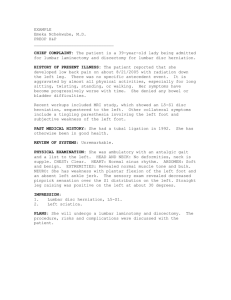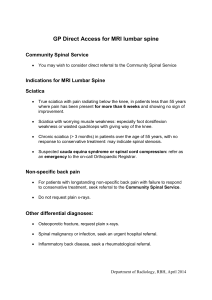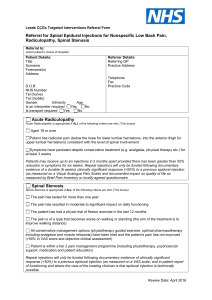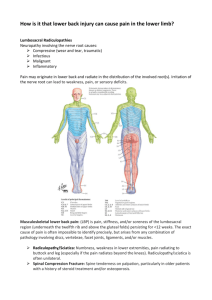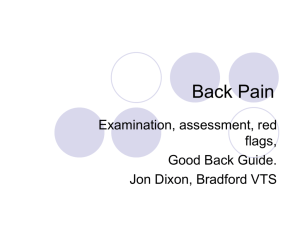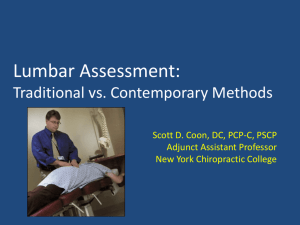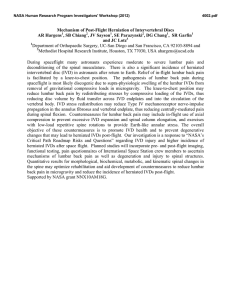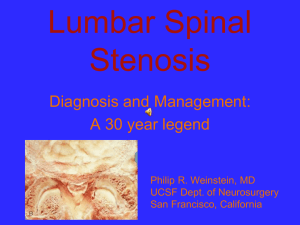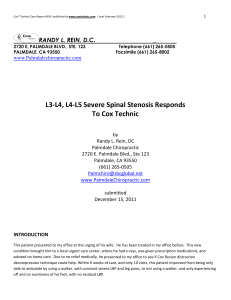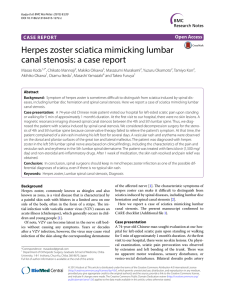Low Back Pain: Approach to the patient in the ED
advertisement
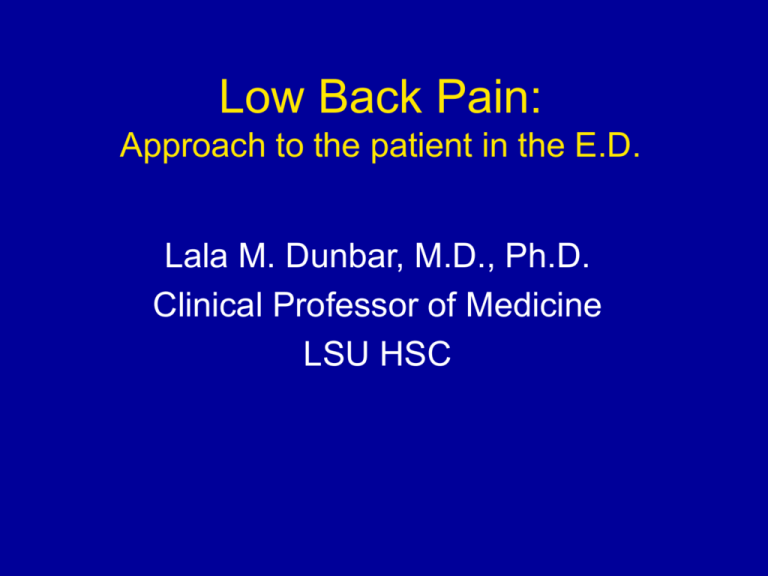
Low Back Pain: Approach to the patient in the E.D. Lala M. Dunbar, M.D., Ph.D. Clinical Professor of Medicine LSU HSC Epidemiology • 60 – 90% of adults experience back pain at some point in their life. - incidence age 35- 55 y.o. - 90% resolve in 6 weeks - 7% become chronic - M/ F equally affected • 85% never given precise pathoanatomical dx • 5th Leading reason for medical office visits • 2nd to respiratory illness as reason for symptom-related MD visits Epidemiology (cont.) • #1 Cause and #1 Cost of work related disability • Healthcare expenditures $90 Billion (1998) - $26.3 Billion attributable to back pain Important Questions 1. Is systemic disease the cause? 2. Is there social or psycological distress that prolongs or amplifies symptoms? 3. Is there neurologic compromise that requires surgical intervention? To Answer These Important Questions 1. Careful History and Physical Exam 2. Imaging and Labs WHEN indicated Differential Diagnosis of Low Back Pain Evaluation in older adults • Probabilities change • Cancer, compression fractures, spinal stenosis, aortic aneurysms more common • Osteoporotic fractures without trauma • Spinal Stenosis secondary to degenerative processes and spondylolisthesis more common • Increased AAA associated with CAD • Early radiography recommended Clues To Systemic Disease • • • • • • • Age History of Cancer Fever Unexplained Weight Loss Injection Drug Use Chronic Infection Elsewhere Duration and Quality of Pain -Infection and Cancer not relieved supine • Response to previous therapy • h/o inflammatory arthritis elsewhere Imaging • Plain Radiography limited to patients with: -findings suggestive of systemic disease -trauma • Failure to improve after 4 to 6 weeks • CT and MRI more sensitive for cancer and infections – also reveal herniation and stenosis • Reserve for suspected malignancy,infection or persistent neurologic defecit MRI • Shows tumors and soft tissues (e.g., herniated discs) much better than CT scan • Almost never an emergency – Exception: Cauda equina syndrome CT Scan • • • • Shows bone (e.g., fractures) very well Good in acute situations (trauma) Sagittal reconstruction is mandatory Soft tissues (discs, spinal cord) are poorly visualized • CT-myelogram adds contrast in the CSF and shows the spinal cord and nerves contour better Abdomen, X-ray, Anteroposterior View 1. 1st Lumbar vertebra 2. 2nd Lumbar vertebra 3. 3rd Lumbar vertebra 4. 4th Lumbar vertebra 5. 5th Lumbar vertebra 6. T12 7. Twelfth rib 8. Sacroiliac joint 9. Sacrum 10. Sacral foramen 11. Ilium 12. Pelvic brim 13.Superior ramus of pubic bone 14. Pubic symphysis Lower Third of Spinal Cord, MRI 1. Vertebral body 2. Spinal cord 3. Conus medullaris 4. Intervertebral disc 5. Filum terminale (internum) 6. Subarachnoid space Sagittal Section through the Spinal Cord 1. Intervertebral disc 2. Vertebral body 3. Dura mater 4. Extradural or epidural space 5. Spinal cord 6. Subarachnoid space Lumbrosacral Dermatones Common Pathoanatomical Conditions of the Lumbar Spine Disc Herniation – Physiology • Tears in the annulus • Herniation of nucleus pulposus Disc Herniation – Physiology • Compression of the nerve root in the foramen leads to pain Lumbar Disc Herniation – Treatment Conservative Tx. – Moderate bed rest – Spinal manipulation – Physical therapy – Medication • NSAIDs • Muscle relaxants • Rarely narcotics Surgical Tx. • “Microdiscectomy” • Less than half of an inch incision • Go home the same or next day • Good results in up to 90% of cases Results of Surgical Treatment • Good outcome in 80-90% of cases • Residual pain may last up to 6 months postop • Results are worse if pain was present for over 8 months before the operation (permanent nerve damage?) Low Back Pain • Second most common cause of missed work days • Leading cause of disability between ages of 19-45 • Number one impairment in occupational injuries Low Back Pain • Most episodes of LBP are self limited • These episodes become more frequent with age • LBP is usually due to repeated stress on the lumbar spine over many years (“degeneration”), although an acute injury may cause the initiation of pain Disc Degeneration – Physiology • With age and repeated efforts, the lower lumbar discs lose their height and water content (“bone on bone”) • Abnormal motion between the bones leads to pain Disc Degeneration – Treatment Conservative Tx. – Moderate bed rest – Spinal manipulation – Physical therapy – Medication • NSAIDs • Muscle relaxants • Rarely narcotics Surgical Tx. • Lumbar fusion OR • Replacement with artificial disc Indications for Surgical Treatment • • • • Low back pain for at least 2 years Incapacitating Resistant to physical therapy and medication Positive MRI findings (degenerative changes) at L4-5 and/or L5-S1 • For selected cases: • Concordant pain on discography • Psychological evaluation Natural History • Recovery from nonspecific LBP generally rapid – 90% within 2 weeks – some studies less rapid (2/3 at 7 weeks) • Herniated Discs – slower to improve – only about 10% considered for surgery after 6 weeks • With surgery, no earlier return to work – symptomatic and functional outcome sometimes better Physical Examination • Fever – possible infection • Vertebral tenderness - not specific and not reproducible between examiners • Limited spinal mobility – not specific (may help in planning P.T. • If sciatica or pseudoclaudication present – do straight leg raise • Positive test reproduces the symptoms of sciatica – pain that radiates below the knee (not just back or hamstring) • Ipsilateral test sensitive – not specific: crossed leg is insensitive but highly specific • L-5 / S-1 nerve roots involved in 95% lumbar disc herniations Assessment of Function • 98% disc herniations: L4-5; L5-S1 • Impairment: Motor and Sensory L5-S1 – L5: Weakness of ankle and great toe dorsaflexion – S1: Decrease ankle reflex – L5 & S1: Sensory loss in the feet STRAIGHT STRAIGHTLEG LEGRAISE RAISETEST TEST The straight leg raise test is positive if pain in the sciatic distribution is reproduced between 30° and 70° passive flexion of the straight leg. Dorsiflexion of the foot exacerbates the pain Waddell Signs For Non-organic Pain • Superficial non-anatomic tenderness • Pain from maneuvers that should not ellicit pain • Distraction maneuvers that should ellicit pain BUT don’t • Disturbances not consistent with known patterns of pain • Over-reacting during the exam • Not definitive to rule out organic disease Imaging Studies • Progressive Neurologic Defecits • Failure to Improve • Hx of Trauma • Risk for Malignancy or infection Nerve Root Pain • Associated w/ Radiculopathy • Sciatica -herniated disk -foramenal or spinal stenosis -ligamentous hypertrophy -other space filling lesions: cysts, tumor, abscess -viral or immune inflammation -can occur w/ peripheral nerve involvement • Spinal stenosis -neurogenic claudication (pseudo claudication) 1 or both legs -radiation to buttocks, thighs, lower legs -pain increase with extension (standing, walking) -pain decrease with flexion (sitting, stooping forward) Indications for Surgical Referral Therapy: Non-specific LBP • • • • • NSAIDS Muscle relaxants Use on schedule than p.r.n. Spinal manipulation/ P.T. (effects limited) Delay referral until pain persists >3 weeks – 50% will improve b/f this time period • • • • Rapid return to normal activities Avoid heavy lifting, trunk twisting, vibrations Alternative Tx: acupuncture and massage Surgery- ineffective unless: – sciatica, pseudoclaudication, spondylolisthesis Therapy: Herniated Disks • If no evidence cauda equina or progressive neurologic defecit: – – – – Treat non-surgically minimum one month Treat similar to non-specific LBP Limited narcotics Epidural steroids (helps in some) • If severe pain or neuro defecits persist: – CT/ MRI / consider for surgery • Diskectomy – Improved relief vs. non-surgery at 4 yrs./ ? 10yrs. – Percutaneous and laser less effective than std. – Arhroscopic techniques techniques comparable to std. surgery Therapy: Spinal Stenosis • Conservative management may be useful • For severe persistant pain decompressive laminectomy • Surgery – better pain relief and functional recovery • 30% recurrent severe pain in 4 years – 10% reoperated Therapy: Chronic LBP • Sx often difficult to explain • Intensive exercises help (hard to maintain) • Anti-depressant therapy useful if depressed • Long term opioids – not recommended • Referral to pain center • Massage therapy is promising • Therapeutic goals – optimize daily function Long Term Outcomes • Herniated Discs w/o neurologic deficits – Diskectomy - > relief at 4 yrs; ? Better at 10 yrs • Microdiskectomy – similar to standard • Laser Diskectomy – less effective • Arthroscopic diskectomy - promising
